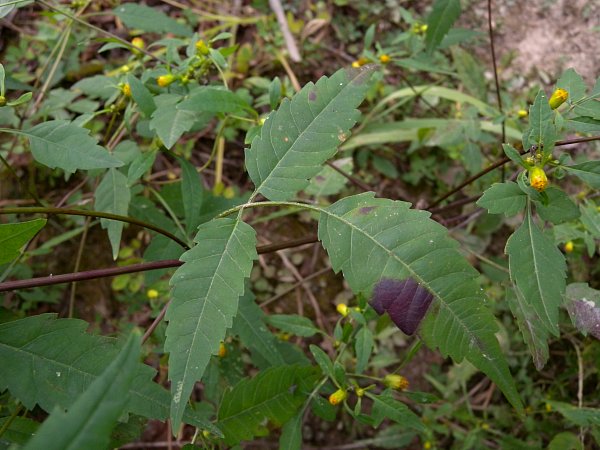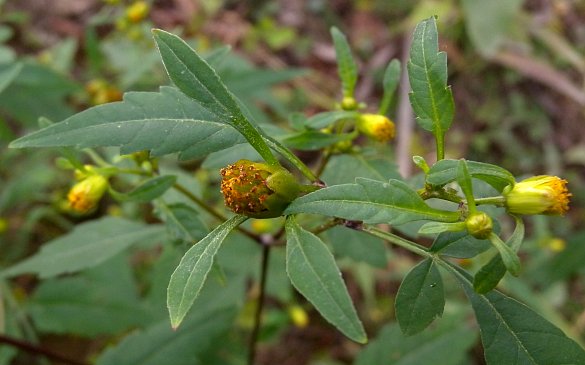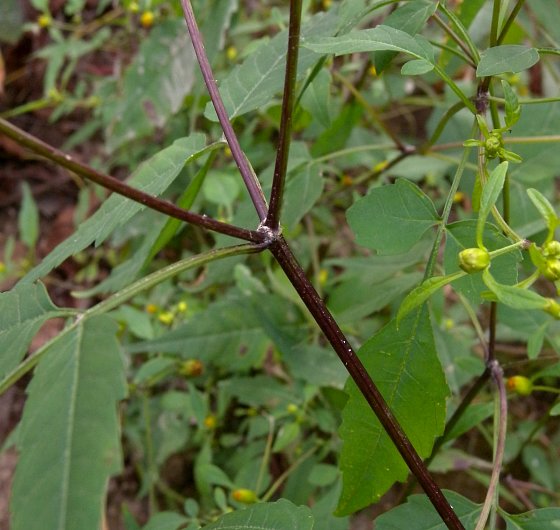
Upper stems terminate in either individual or small clusters of 2-3 flowerheads. The peduncles of these flowerheads are relatively short (up to 12 mm. or ½" long). Each flowerhead is about 3-6 mm. across (excluding the outer bracts), consisting of 10-20 disk florets and no ray florets. The corollas of disk florets are yellow, short-tubular in shape, and 5-lobed; they are about 3 mm. long. Originating from the base of each flowerhead, there are 2-5 leafy outer bracts. The outer bracts are medium green, narrowly oblanceolate or elliptic in shape, and glabrous (or nearly so); they are up to 1½" (4 cm.) long and 8 mm. across (usually about one-half the maximum size, but highly variable). Around the base of each flowerhead, there are several inner bracts. These inner bracts are 4-6 mm. long, light green or yellowish green, oblong-ovate in shape, and appressed together in a slightly overlapping single series. The blooming occurs from late summer into the fall, lasting about 1½-2 months. In the absence of cross-pollination, the disk florets are self-fertile. Afterwards, the disk florets are replaced by achenes with pairs of awns. The achenes (excluding their awns) are about 4 mm. long, 1-1.5 mm. across, and flattened-oblanceoloid in shape; they are truncate at their apices, while their outer sides have faint midribs. The barbed awns of these achenes (2 awns per achene) are about 1 mm. in length. Mature achenes are greenish brown to dark brown.

The root system is shallow and fibrous. This plant reproduces primarily by reseeding itself. The lower nodes of its stems can develop rootlets when they contact moist ground. Occasionally, colonies of plants of variable size will develop at favorable sites.
Cultivation: The preference is full or partial sun, wet to moist conditions, and soil containing loam or decaying organic material. Sometimes this plant establishes itself on fallen logs or the lower trunks of trees. Standing water is tolerated if it is temporary.
Range & Habitat: The native Swamp Beggar's Ticks is occasional in southern and central Illinois, while in the northern section of the state it is rare or absent (see Distribution Map). Habitats include swamps, banks of lakes, margins of ponds, low areas along rivers, and limestone sinkholes. This plant can be found in either disturbed or higher quality wetlands, favoring humid areas where there is some protection from the wind.

Faunal Associations: The non-showy flowerheads attract relatively few insect pollinators, although sometimes bees (including Halictid bees) and flies (including Syrphid, Tachinid, and bee flies) will suck on the nectar and/or collect pollen. In general, the foliage, stems, and other parts of Bidens spp. are a source of food for such insects as aphids (including Aphis coreopsidis & Brachycauda helichrysi), larvae of the fruit fly, Icterica seriata, larvae of leaf-mining flies (including Amauromyza maculosa & Calycomyza frickiana), caterpillars of the butterfly, Nathalis iole (Dainty Sulfur), larvae of several moths (including Cirrhophanus triangulifer & Epiblema otiosana), and leaf beetles (Calligrapha bidenticola & Calligrapha californica). See the Insect Table for a more complete listing of these species. The achenes or seedheads of Bidens spp. are consumed by some species of waterfowl, upland gamebirds, and songbirds, including the Mallard, Wood Duck, Greater Prairie Chicken, Ring-Necked Pheasant, Bobwhite Quail, Purple Finch, Common Redpoll, and Swamp Sparrow (Martin et al., 1951/1961; Havera, 1999; Schwartz, 1945). In addition, the Snapping Turtle (Chelydra serpentina), Blanding's Turtle (Emys blandingii), and the Painted Turtle (Chrysemys picta) sometimes feed on the seeds and/or foliage of these plants (Lagler, 1943; Ernst et al., 1994). The foliage is browsed sparingly by the White-Tailed Deer and the Cottontail Rabbit. The awned achenes can cling to the feathers of birds, the fur of mammals, and the clothing of humans, which spreads Swamp Beggar's Ticks and other Bidens spp. to new locations.

Photographic Location: Border of a lake at Walnut Point State Park in Douglas County.
Comments: This is one of the Bidens spp. in Illinois with non-showy flowerheads because it lacks ray florets. Species in this group are often referred to as "Beggar's Ticks." Once the flowerheads are produced, Swamp Beggar's Ticks (Bidens discoidea) is fairly easy to distinguish from two similar species with 2-awned achenes, namely Common Beggar's Ticks (Bidens frondosa) and Tall Beggar's Ticks (Bidens vulgata). Most noticeably, the flowerheads of Swamp Beggar's Ticks have fewer outer bracts (typically 3-4) than those of Common Beggar's Ticks (typically 6-11) and Tall Beggar's Ticks (typically 13-20). In addition to having fewer outer bracts than these species, it also has smaller achenes with shorter awns. In contrast to the preceding species, other non-showy Bidens spp. in Illinois, such as Purple-Stemmed Tickseed (Bidens connata) and Three-Lobed Beggar's Ticks (Bidens comosa), can be distinguished from the preceding species by their 3- or 4-awned achenes. Sometimes Nodding Bur-Marigold (Bidens cernua) also lacks ray florets, but it has only simple leaves and its achenes are 4-awned. In comparison to the preceding Bidens spp., Swamp Beggar's Ticks has a rather delicate appearance because of its thin leaves and relatively small size.